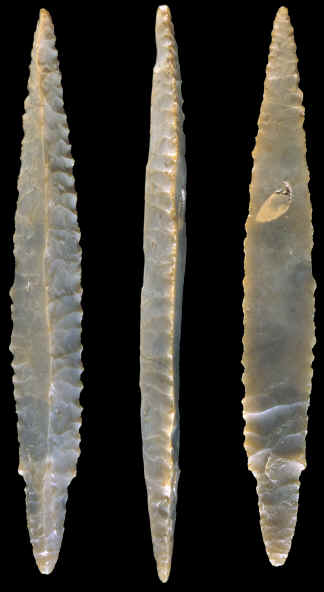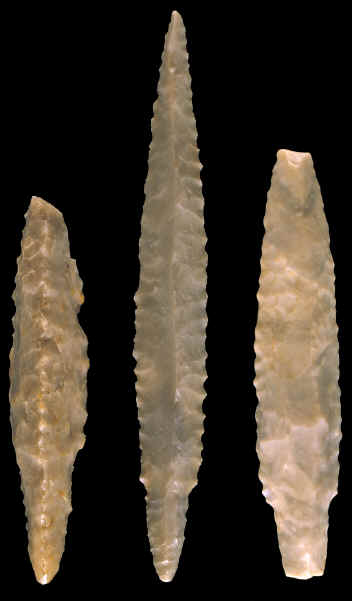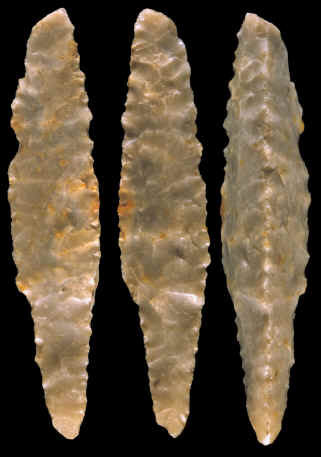|
PAGE
3 CONTINUED
FROM PAGE 2
THREE
SIDED POINTS
NEOLITHIC
PERIOD & LATE STONE AGE
NORTHERN
EUROPE & PANAMA
PAGE 1
OF 4 PAGES

THREE
SIDED BLADE POINT
NEOLITHIC PERIOD
ISLAND OF LOLLAND, DENMARK
PRIVATE COLLECTION
This three sided blade point was recovered on a site in northern
Europe on the Island of Lolland in
Denmark. This arrow point dates to the Neolithic period and was
probably made sometime before 2200 B.C. It was made from a long narrow blade that was struck
off a prepared core. Two
sides and more than half of the third side was skillfully
pressure flaked into a three sided point. This arrow point is
made of Danish flint and measures 3 11/16 inches (10 cm) long,
1/2 inch (1.2 cm) wide and 1/4 inch ( 6 mm) thick. |
|
|
The three sided blade points from northern Europe are the most skillfully
manufactured examples of these unique projectile point forms. They evolved from points made on blades during the
Middle Neolithic period. The earliest examples were made on blades with
points but no stems. Later examples developed the stems and finally,
they evolved into the three sided forms.
|
|

CLICK ON
PICTURE FOR LARGE IMAGE
THREE SIDED BLADE POINTS
NEOLITHIC PERIOD
NORTHERN EUROPE
PRIVATE COLLECTION
These three arrow points were found on sites in northern Europe. The
point in the middle was collected on the island of Lolland in
Denmark and the point on the right is also from Denmark. They date to the
Neolithic period and were probably made sometime before 2200 B.C.
They were all made from blades struck from prepared cores. The
blades were then pressure flaked into three sided points. The points
on the left and right have tip damage that may be the result of
impact fractures from when they were once attached to arrow
shafts. The point on the right also has some damage to the end of
the stem. These three points are made from Danish flint. The longest
example in the center measures 3 11/16 inches (10 cm) long,
1/2 inch (1.2 cm) wide and 1/4 inch ( 6 mm) thick. |
|
|
Three
sided blade points were made by the Pitware culture during the Middle
Neolithic period, approximately 4,200 years ago. These people lived in
settlements along the southern coast and islands of Sweden. The people
who made these points lived on fishing, hunting seals and the raising of
pigs.
|
|

CLICK ON
PICTURE FOR LARGE TRIPLE IMAGE
THREE SIDED BLADE POINT
NEOLITHIC PERIOD
NORTHERN EUROPE
PRIVATE COLLECTION
This three sided blade point is fully flaked on all three sides and
there is an impact fracture on the tip of the point. This arrow
point is made of Danish flint and measures 2 5/8 inches (6.6 cm)
long and 1/2 inch (1.2 cm) wide. |
|
|
Three
sided points stand out as a unique flaked stone projectile point design. At least
when compared to the multitudes of other forms that have been found on
ancient sites around the world. The reason why these two different
cultures began making projectile points with three sides will probably
never be known. But their design is no more mysterious than other even
more complicated forms---such as, for example, Folsom points.
|
|
"REFERENCES"
1889,
Holmes, William H., "Ancient Art of the Province of Chiriqui
(Panama)," Vol. 14, Annual Report of the Bureau of Ethnology, p. 34.
1952, Glob, P.V. "Danish Antiquities, II Late Stone Age," pp.
102-103.
|
|
HOME
ORDERING |


